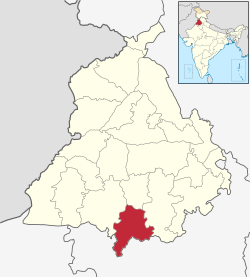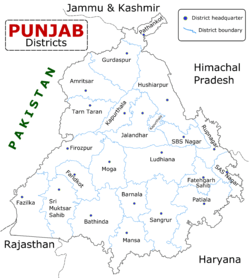Mansa district, Punjab
| Mansa district ਮਾਨਸਾ ਜ਼ਿਲ੍ਹਾ | |
|---|---|
| District | |
 | |
| Coordinates: 29°59′N 75°23′E / 29.983°N 75.383°ECoordinates: 29°59′N 75°23′E / 29.983°N 75.383°E | |
| Country |
|
| State | Punjab |
| Headquarters | Mansa |
| Area‡[›] | |
| • Total | 2,174 km2 (839 sq mi) |
| Population (2011) | |
| • Total | 768,808 |
| • Density | 350/km2 (900/sq mi) |
| Languages | |
| • Official | Punjabi |
| Time zone | IST (UTC+5:30) |
| ISO 3166 code | IN-PB |
| Vehicle registration | PB-31 |
| Sex ratio | 1000/880 ♂/♀ |
| Literacy | 63% |
| Website |
www |
Mansa district (Punjabi: ਮਾਨਸਾ ਜ਼ਿਲ੍ਹਾ) falls under the Indian state of Punjab. The headquarters is Mansa city. Mansa district was formed on 13 April 1992 from the erst while district of Bathinda.[1] The district has three tehsils,[2] Budhlada, Mansa and five development blocks, Bhikhi, Budhlada, Mansa, Jhunir and Sardulgarh with three sub-tehsils.
Geography

The district is roughly triangular in shape, and is bounded on the northwest by Bathinda district, on the northeast by Sangrur district, and on the south by Haryana state. It is situated on the Bathinda-Jind-Delhi railway and the Barnala-Sardulgarh-Sirsa road. The district is divided into three tehsils, Budhlada, Mansa, and Sardulgarh. The Ghaggar River flows through the Sardulgarh tehsil in the southwestern corner of the district.
Punjabi is the mother tongue as well as the official language of the district.
History
Mansa District was formerly a part of Phulkia Sikh Dynasty (1722–1948) then part of Kaithal Sikh Kingdom (1762–1857). The present district was formed on 13 April 1992 from the erstwhile Bathinda district. The town is said to have been founded by Bhai Gurdas who hailed from Dhingar, Distt. Mansa. He is said to have been married at this place among the Dhaliwal Jat Sikh. Once he came to his in-laws to take his wife along with him but they refused to send her. At this, Bhai Gurdas sat in meditation before the house of his in-laws. After some time, the parents of the girl agreed to send their daughter with Bhai Gurdas. But he refused to take her along with him, stating that he had now renounced the worldly way of life. In his memory, his Smadh was constructed where a fair is held every year in March–April. People in large numbers attend the fair and offer Laddus and Gur at Smadh. Class ‘A’municipality has been functioning in the town since 1952.The town has two Colleges, viz. Govt. Nehru Memorial Post Graduate College and S.D. Kanya Mahavidyala College, 3 Senior Secondary School, 90 High School, 1 Middle School and 1 Primary School and one Distt. Library and has one civil hospital, 3 dispensaries and 1 Ayurvedic and 1 Homeopathic dispensary. There are two police stations i.e. PS City and PS Sadar and also a railway station.
Ancient period
The ancient history of the Mansa district has been traced to the Indus Valley civilization. The archaeological finds at different villages of Mansa district are almost similar to those of Harappa and Mohanjodaro.[3][4] It is divided into three parts Pre-Harappa, Harappa and Late Harappa.
Demographics
According to the 2011 census Mansa district has a population of 7,68,808,[6] roughly equal to the US state of Alaska.[7] This gives it a ranking of 489th in India (out of a total of 640). The district has a population density of 350 inhabitants per square kilometre (910/sq mi). Its population growth rate over the decade 2001-2011 was 11.62%. Mansa has a sex ratio of 880 females for every 1000 males and a literacy rate of 62.8%.[6]
Agriculture and industry
Mansa is situated in the cotton belt of Punjab and therefore popularly called the "Area of white gold". Indeed, agriculture forms the backbone of the district economy.
Mansa is home to the largest Thermal Power Plant of Punjab.The Thermal Power Plant has a capacity to produce 1980MW of electricity
Industrially, the district is very deficient, yet some trade and industry is being carried out in urban areas.
Major cities and towns
BARETA
It is situated on Bathinda-Delhi railway line. It is cleanest city in Mansa district.
Budhlada
Budhlada was named after the two brothers, Budha and Ladha, who were khatri by caste. It is also situated on Bathinda-Delhi railway line. It was the largest market of Eastern Punjab and a very big recruitment centre for military personnel.
Notable people
- Sawarn Singh -(in Punjabi ਸਵਰਨ ਸਿਂਘ) is an Indian rower as well as Naib Subedar in Indian Army . He was born on 20 February 1990 at Dalelwala Mansa in Punjab, India. He primarily competes in single scull events.He is bronze medalist of 2014 Asian Games held at South Korea. He has qualified for 2012 Summer Olympics in Men's single scull event and reached last eight (7:00.49, 2 km). Swarn Singh Virk secured his spot in the London Olympics by winning his event at the FISA Olympic Continental Qualification Regatta for Asia in Chung Ju, Korea. The 21-year-old Virk qualified in the men's single sculls even for the mega-event.
London Olympics was the maiden Olympics appearance for the Jharkhand National Games gold medallist.
- Gavie Chahal -Bollywood/Punjabi Movie actor, hails from Village Sher Khan Wala
- Kulwinder Billa -Punjabi Record Artist, hails from the Village Dhaipi of the district
- Ajmer Singh Aulakh - Sahitya Academy Winner for Best Drama Director, hails from village Kishagarh Farwaahi
References
- ↑ "About | Mansa". www.mansa.nic.in. Retrieved 2016-07-06.
- ↑ "Gurpreet gets Mansa seat". News in English. Ludhiana. The Tribune. 10 January 2012. Retrieved 17 July 2012.
- ↑ Lal, B.B; Gupta, S.P. (1984) [1981-82]. Frontier of Indus Valley Civilization. Delhi.
- ↑ "Ancient history of Mansa district". B.B. Lal and S.P. Gupta. www.punjabrevenue.nic.in. Retrieved 23 January 2012.
- ↑ http://www.census2011.co.in/census/district/600-mansa.html
- 1 2 "District Census 2011". www.census2011.co.in. 2011. Retrieved 22 January 2012.
- ↑ "2010 Resident Population Data". U. S. Census Bureau. Retrieved 2011-09-30.
Alaska 710,231
